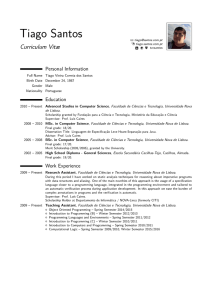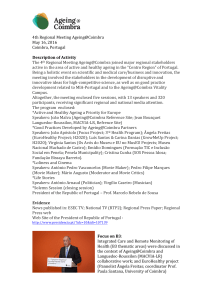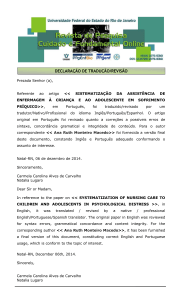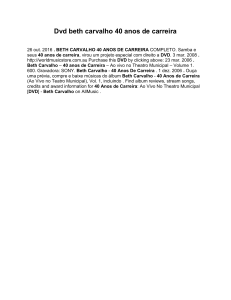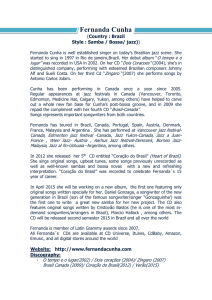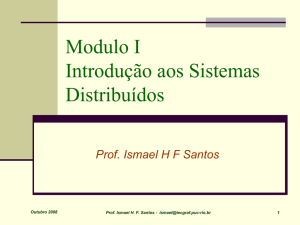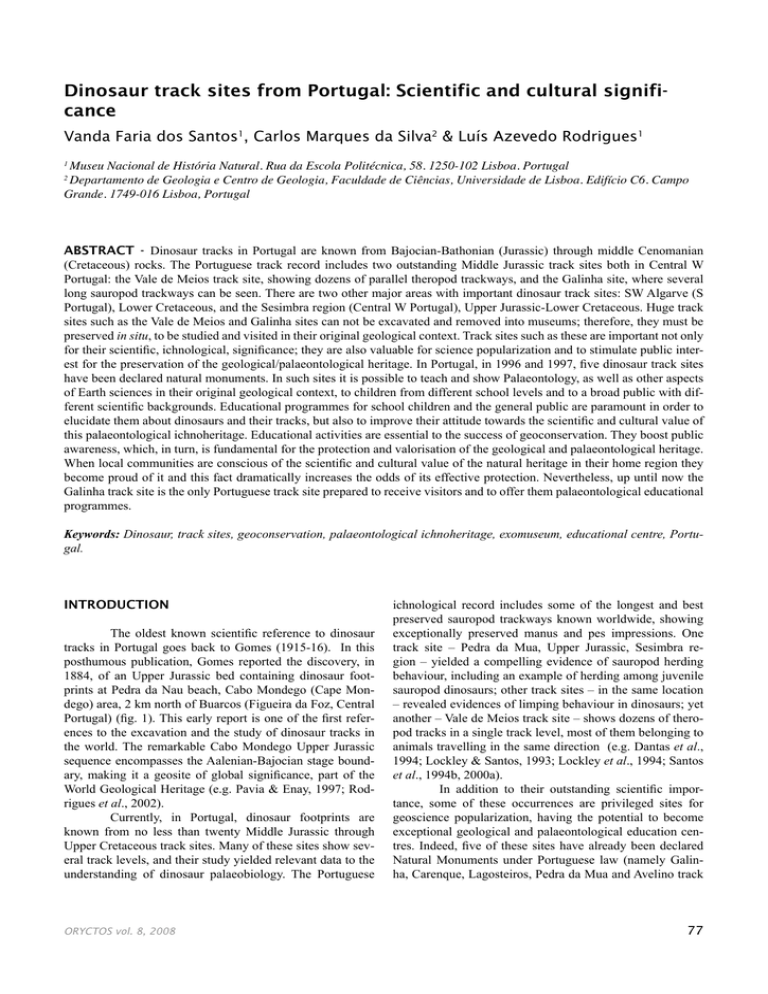
Dinosaur track sites from Portugal: Scientific and cultural significance
Vanda Faria dos Santos1, Carlos Marques da Silva2 & Luís Azevedo Rodrigues1
Museu Nacional de História Natural. Rua da Escola Politécnica, 58. 1250-102 Lisboa. Portugal
Departamento de Geologia e Centro de Geologia, Faculdade de Ciências, Universidade de Lisboa. Edifício C6. Campo
Grande. 1749-016 Lisboa, Portugal
1
2
ABSTRACT - Dinosaur tracks in Portugal are known from Bajocian-Bathonian (Jurassic) through middle Cenomanian
(Cretaceous) rocks. The Portuguese track record includes two outstanding Middle Jurassic track sites both in Central W
Portugal: the Vale de Meios track site, showing dozens of parallel theropod trackways, and the Galinha site, where several
long sauropod trackways can be seen. There are two other major areas with important dinosaur track sites: SW Algarve (S
Portugal), Lower Cretaceous, and the Sesimbra region (Central W Portugal), Upper Jurassic-Lower Cretaceous. Huge track
sites such as the Vale de Meios and Galinha sites can not be excavated and removed into museums; therefore, they must be
preserved in situ, to be studied and visited in their original geological context. Track sites such as these are important not only
for their scientific, ichnological, significance; they are also valuable for science popularization and to stimulate public interest for the preservation of the geological/palaeontological heritage. In Portugal, in 1996 and 1997, five dinosaur track sites
have been declared natural monuments. In such sites it is possible to teach and show Palaeontology, as well as other aspects
of Earth sciences in their original geological context, to children from different school levels and to a broad public with different scientific backgrounds. Educational programmes for school children and the general public are paramount in order to
elucidate them about dinosaurs and their tracks, but also to improve their attitude towards the scientific and cultural value of
this palaeontological ichnoheritage. Educational activities are essential to the success of geoconservation. They boost public
awareness, which, in turn, is fundamental for the protection and valorisation of the geological and palaeontological heritage.
When local communities are conscious of the scientific and cultural value of the natural heritage in their home region they
become proud of it and this fact dramatically increases the odds of its effective protection. Nevertheless, up until now the
Galinha track site is the only Portuguese track site prepared to receive visitors and to offer them palaeontological educational
programmes.
Keywords: Dinosaur, track sites, geoconservation, palaeontological ichnoheritage, exomuseum, educational centre, Portugal.
INTRODUCTION
The oldest known scientific reference to dinosaur
tracks in Portugal goes back to Gomes (1915-16). In this
posthumous publication, Gomes reported the discovery, in
1884, of an Upper Jurassic bed containing dinosaur footprints at Pedra da Nau beach, Cabo Mondego (Cape Mondego) area, 2 km north of Buarcos (Figueira da Foz, Central
Portugal) (fig. 1). This early report is one of the first references to the excavation and the study of dinosaur tracks in
the world. The remarkable Cabo Mondego Upper Jurassic
sequence encompasses the Aalenian-Bajocian stage boundary, making it a geosite of global significance, part of the
World Geological Heritage (e.g. Pavia & Enay, 1997; Rodrigues et al., 2002).
Currently, in Portugal, dinosaur footprints are
known from no less than twenty Middle Jurassic through
Upper Cretaceous track sites. Many of these sites show several track levels, and their study yielded relevant data to the
understanding of dinosaur palaeobiology. The Portuguese
ORYCTOS vol. 8, 2008
ichnological record includes some of the longest and best
preserved sauropod trackways known worldwide, showing
exceptionally preserved manus and pes impressions. One
track site – Pedra da Mua, Upper Jurassic, Sesimbra region – yielded a compelling evidence of sauropod herding
behaviour, including an example of herding among juvenile
sauropod dinosaurs; other track sites – in the same location
– revealed evidences of limping behaviour in dinosaurs; yet
another – Vale de Meios track site – shows dozens of theropod tracks in a single track level, most of them belonging to
animals travelling in the same direction (e.g. Dantas et al.,
1994; Lockley & Santos, 1993; Lockley et al., 1994; Santos
et al., 1994b, 2000a).
In addition to their outstanding scientific importance, some of these occurrences are privileged sites for
geoscience popularization, having the potential to become
exceptional geological and palaeontological education centres. Indeed, five of these sites have already been declared
Natural Monuments under Portuguese law (namely Galinha, Carenque, Lagosteiros, Pedra da Mua and Avelino track
77
Figure 1 – Location of the main
Portuguese tracksites in the Lusitanian (West Portugal) and Algarve
Mesozoic basins (South Portugal).
sites) clearly reflecting their scientific, educational and cultural relevance. Nevertheless, so far, only the Galinha track
site boasts operating educational programs and facilities capable of receiving and orientating visitors.
Fossils, the fossils of dinosaurs in particular, have
always captured the public’s interest. This characteristic
of fossils may and should be used to enthral public attention and to focus it, also, on general geological aspects and
on geoconservation issues. The Palaeontological Heritage
is, therefore, a powerful driving force for geoconservation
(Cachão et al., 1999). The pride of local populations in their
ichnoheritage fuels geoawereness and boosts their interest
for geoconservation. This is crucial for effective site protection. Geoconservation-wise, this “geocultural identification”
factor is more effective for the protection of the sites than the
mere knowledge of their abstract scientific importance.
78
RELEVANT PORTUGUESE DINOSAUR TRACK
SITES
Portuguese dinosaur track sites are mainly located
in the Lusitanian basin (Western Portugal), and only three
in the SW tip of the Algarve basin (S Portugal) (fig. 1). The
Middle Jurassic track record is represented by Galinha and
Vale de Meios track sites. Upper Jurassic dinosaur tracks are
well documented at Figueira da Foz (Cabo Mondego track
site), Sesimbra (Avelino and Ribeira do Cavalo track sites)
and Cabo Espichel (Cavalo and Pedra da Mua track sites).
In the Algarve basin it is known one Upper Jurassic track
site at Foia do Carro bay, near Vila do Bispo village. Lower
Cretaceous track sites are also known on the top of the cliff
that borders the northern side of the small bay of Lagosteiros
at Cabo Espichel (Lagosteiros track site) and near Óbidos
ORYCTOS vol. 8, 2008
Figure 2 – Wide-gauge sauropod trackway at
Galinha track site (Bajocian-Bathonian, Ourém Torres Novas, Portugal).
(Olhos de Água track site, Mateus & Antunes, 2003) and in
the Algarve: Salema and Santa track sites (Vila do Bispo).
The Upper Cretaceous dinosaur track record is represented
by the Carenque track site.
The Galinha track site
The Galinha track site is situated at a former limestone quarry near Fátima, on the eastern side of Serra d’Aire
(West-Central Portugal), 120 km north of Lisbon. Several
long sauropod trackways were discovered in the Galinha site
in 1994 by João Carvalho, of the Torres Novas Speleological
and Arqueological Society.
The tracks are located on 40.000 m2 bedding surface, especially cleaned for their study with the cooperation
of the former quarry owner Rui Galinha and the collabora-
ORYCTOS vol. 8, 2008
tion of the natural park Parque Natural das Serras d’Aire e
Candeeiros (PNSAC). The site can be accessed without difficulty. The track level is located on a sub-horizontal bedding
plane and displays long and visually spectacular wide-gauge
sauropod trackways composed of sauropod pes and manus
prints quite deeply impressed (Fig. 2) that can be easily observed from the high ground surrounding the former extracting area of the quarry. The wide-gauge long sauropod trackways are preserved on Middle Jurassic (Bajocian-Bathonian)
limestones (Azeredo et al., 1995) and some consist of manus
impressions only. In this track site are noticeable very well
preserved sauropod manus and pes print morphologies (Santos et al., 1994b). Manus impressions reveal clear traces of
digit I. The manus/pes area ratio is 1/2 and is different from
ratios ranging up to 1/3 or 1/5 in other sauropod tracks suggesting a unique type of footprint (Santos et al., 1994b).
79
Figure 3 (left) – Theropod footprints at Vale de Meios track sites
(Bathonian, Santarém, Portugal). Photograph by Luis Quinta.
Figure 4 (below) – Tetradactyl theropod footprints at Cabo Mondego track site (Oxfordian, Figueira da Foz, Portugal) (Lockley et
al., 1996).
Since the Middle Jurassic dinosaur track record,
and especially the sauropod track record, are poorly known
(e.g. Clark et al., 2005; Clark & Barco Rodriguez, 1998; Day
et al., 2004; Kvale et al., 2004; Lockley et al., 2007), the
Galinha track site represents a considerable source of information on the Middle Jurassic sauropod palaeobiology.
The Vale de Meios track site
In 1998 several theropod dinosaur trackways were
identified at Vale de Meios by Maria da Glória Araújo, Luís
António Ferreira and António Frazão of the natural park
Parque Natural das Serras d’Aire e Candeeiros (e.g. Santos
et al., 2000a; Santos, 2003; Santos & Rodrigues, 2003). This
site, situated near Alcanede village (Santarém, Central Portugal), is located in a working quarry extracting limestone of
Bathonian age from the Maciço Calcário Estremenho (Estremenho Calcareous Massif) sedimentary formations. This
track site, with an area of about 10.000 m2, shows dozens
of trackways (fig. 3), several of them displaying parallel
displacement directions (Santos et al., 2000a; Santos, 2003;
Santos & Rodrigues, 2003).
The Vale de Meios track site is presently under
80
study. The ichnological survey is under way and the surface
map of the site is currently being drawn in order to support
its paleobiological and paleoecological interpretation. Preliminary research at Vale de Meios showed that it contains
the most significant example of Middle Jurassic theropod
footprints and trackways in Portugal. These trackways provide key evidence of theropod foot structure, locomotion and
behaviour.
Theropod trackway-wise, the Middle Jurassic is a
poorly known episode of geological history; therefore new
discoveries are particularly important. The research at Vale
de Meios track site will provide an important contribution
to the knowledge of Middle Jurassic dinosaur communities
and, therefore, its future preservation is crucial.
This site has good natural conditions to receive
school children and the general public with little investment
in basic infrastructures. The track site is easily accessible,
and the tracks are located on a horizontal bedding surface.
The Cabo Mondego track site
This dinosaur track site is situated at Cabo Mondego, close to Figueira da Foz city. This was the first dinosaur
ORYCTOS vol. 8, 2008
track site discovered and studied in Portugal. At Cabo Mondego, Gomes (1915-1916) described large theropod tetradactyl footprints preserved as natural casts in Upper Jurassic
deposits (Oxfordian). The morphology exhibited by these
tracks is characterized by a long digit I mark and a metatarsal impression (fig. 4). These theropod tracks were attributed
to the ichnospecies Megalosauripus lusitanicum (Lockley et
al., 1996, 1998). At this track site, at least eight stratigraphic
levels with theropod tracks were identified (Santos, 2003).
The Sesimbra - Espichel Region track sites
Between the locality of Sesimbra and the Cabo Espichel (cape Espichel) region, near Setúbal, five dinosaur
track sites, comprising at least twenty different track levels,
have been identified (fig. 1). These sites are: the Avelino and
the Ribeira do Cavalo quarries, at Zambujal village, near Sesimbra, and the Cavalo, Pedra da Mua, and Lagosteiros sites
in the Cabo Espichel area. Avelino, Pedra da Mua and Lagosteiros track sites were declared natural monuments on the
basis of their scientific value, the exceptional natural scenery
surrounding them and the potential to host educational programmes and pedestrian tours to visit dinosaur tracks.
At the Avelino track site, on Kimmeridgian limestones, narrow-gauge sauropod trackways were described
(fig. 5), and assigned to Parabrontopodus isp. (Lockley &
Santos, 1993). These trackways reveal the passage of five
different sized sauropod trackmakers (pes prints length ranging from 30 to 100 cm) travelling separately in different directions.
Until the discovery of Vale de Meios track site, in
1998, well preserved theropod trackways where known only
from the Ribeira do Cavalo quarry on a vertical bedding surface of Oxfordian-Kimmeridgian age (Lockley et al., 1992).
Here, a manus dominated sauropod trackway with digit impressions was also described and a manus replica was made
(Lockley et al., 1992). The site collapsed in 1995, due to lack
of protection, destroying all the track records existing there
(Santos et al., 1995).
In the coastal cliffs between Cabo Espichel and Lagosteiros bay (SW Setúbal) there are several dinosaur track
levels in a stratigraphic sequence of Portlandian age (Upper
Jurassic).
The Praia do Cavalo (Cavalo beach) is a track site
located immediately to the South of Lagosteiros bay. In this
site a trackway of a large theropod has been recorded and it
was recognized a limping gait (Dantas et al., 1994).
At Lagosteiros bay, the cliff beneath the Sanctuary
of Cabo Espichel, known as the Pedra da Mua track site,
reveals at least eight levels with 38 sauropod trackways
and two theropod trackways (Lockley et al., 1994). Sauropod trackways are all wide-gauge (Brontopodus type) and
show well-preserved Upper Jurassic Brontopodus footprint
specimens, showing four claw marks (Meyer et al., 1994).
In one of the Pedra da Mua track levels, seven parallel sauropod trackways, showing the same travel direction, were
ORYCTOS vol. 8, 2008
recognized and described. These trackways are composed of
footprints having similar sizes and depths (footprint length
ranging from 38 to 46 cm). The analysis of these parallel
trackways revealed that their producers were travelling at
similar speeds (Lockley et al., 1994). Along these trackways
three other trackways of larger animals, with footprint length
ranging from 70 to 73 cm, progressing in the same direction
may be observed (Lockley et al., 1994). This record represents the first compelling evidence of sauropod gregarious
behaviour in the European track record and an interesting example of herd behaviour among young sauropods (Lockley
et al., 1994). At Pedra da Mua track site there is a sauropod
trackway with irregular pace length which is another example of a limping gait revealed in a dinosaur trackway (Dantas
et al., 1994; Meyer et al., 1994).
The Lower Cretaceous (Hauterivian) Lagosteiros
track site was discovered in 1971 on the top of the cliff north
of Lagosteiros bay (Antunes, 1976). The most prominent
feature of this track site is a long sequence of poorly preserved subcircular impressions, with similar size and depth,
attributed to a bipedal animal, probably an ornithopod (e.g.
Santos et al., 1992a; Santos, 2003). The site also shows several tridactyl impressions of small theropods, but only one
short trackway is identifiable. In this theropod trackway it is
possible to estimate a displacement speed value of about 14
km/h. This is the sole evidence of a fast moving dinosaur in
the Portuguese track record (Santos, 2003).
Portuguese Lower Cretaceous track sites are also
known from the coastal area of Óbidos (Central-West Portugal), 80 km north of Lisbon. Several theropod and ornithopod dinosaur trackways have been described from this
site. For further information and location map see Mateus &
Antunes (2003).
The Algarve Region track sites
In 1992 and 1995 the first dinosaur osteological and
ichnological remains were found in the Algarve Mesozoic
Basin at the Praia de Porto de Mós (Porto de Mós beach,
Lagos), and at Praia da Salema (Salema beach), close to Vila
do Bispo, respectively (Santos et al., 2000b,c; Santos, 2003).
Since then, two more algarvian track sites were identified
and documented.
At Porto de Mós beach, in a layer of Aptian age
(Gargasian/Clansayesian, according to Rey 1983) dinosaur
teeth and longitudinal sections of vertebras were recognized
(Santos et al., 2000b).
At the Salema track site two track levels were recognized on beds of Barremian age (e.g. Santos, 2003). The
western track level reveals an ornithopod trackway. The best
preserved footprint in this trackway displays the characteristic morphology of iguanodontid footprints. To the East of
this slab, another track level was found with seven isolated
theropod footprints.
Other Lower Cretaceous dinosaur track levels were
found at Praia Santa (Santa beach), to the West of Salema
81
Figure 5 – Narrow-gauge sauropod
trackway at Avelino track site (Upper Kimmeridgian, Sesimbra, Portugal). Photograph by Luis Quinta.
beach (Santos et al., 2000c). The main level revealed at least
four bipedal trackways and isolated footprints. The well
preserved prints in Santa track site reveal the characteristic
iguanodontid morphology and their similarity with the prints
attributed to Iguanodontipus isp. allows their assignment to
this ichnogenus (Santos, 2003; Santos et al., 2000c). Until
now, it was recognized the presence of iguanodontid and
small unidentified theropods in the Lower Cretaceous of the
Mesozoic Algarve basin (Santos et al., 2000b,c).
Sauropod trackways were also identified in two Upper Jurassic levels at Foia do Carro track site, close to Vila do
Bispo village (e.g. Santos, 2003; Santos et al., 2000b).
82
The Carenque track site
The most recent dinosaur track site in Portugal is situated at Pego Longo (also known as Carenque),
approximately 12 km NW of Lisbon, and it is Cenomanian
in age (Upper Cretaceous). It was discovered in 1985 (Coke
& Monteiro, 1986) and reveals theropod trackways and a
single long trackway of a large bipedal animal. When first
described, this trackway - with a total length of 127 m - was
deemed the world’s longest dinosaur trackway known (Santos et al., 1991, 1992a, b). This long bipedal dinosaur trackway is the main ichnological feature of the Carenque track
ORYCTOS vol. 8, 2008
site. The trackway is composed of a sequence of subcircular
impressions without morphological details. It displays some
unusual features of preservation, making it difficult to identify the trackmaker, however the pace angulation criterion
suggests the attribution of this trackway to a bipedal dinosaur (Santos et al., 1992a).
PORTUGUESE DINOSAUR ICHNOHERITAGE
heritage
Pioneer campaign to preserve the ichonological
The study of a long dinosaur trackway at Carenque
(Pego Longo) track site initiated the pioneer task of protecting the Portuguese ichnoheritage (e.g. Cachão et al., 1998,
1999; Galopim de Carvalho, 1989, 1994, 1998; Galopim
de Carvalho & Santos, 1992a,b; Galopim de Carvalho et
al., 1996, 1998; Santos et al., 1991, 1992a,b, 1994a; Silva
et al., 1998). The Carenque site was located exactly in the
path of a motorway construction project and, therefore, destined to be destroyed. This circumstance started, in 1992, the
so-called Battle of Carenque (Galopim de Carvalho, 1994).
The scientific community started a joint effort to promote
public awareness, to inform the public of the dinosaur footprints scientific and ichnoheritage potential. In the end, the
involvement of the population and the local authorities was
crucial for the geoconservation of this site.
In response to the overwhelming public interest on
this site, the Portuguese Government was compelled to take
action in order to protect the site from destruction. President
Mário Soares, first, and the Portuguese Government, later,
voted unanimously to preserve the site from destruction, by
building a tunnel beneath it. In order to build the tunnel under the site, in 1993, the main Carenque trackway, as a protection measure, was covered. After the spur of the moment,
unfortunately, the trackway remained covered and, therefore,
unavailable for researchers and for the general public. The
Carenque site, after all these years, still awaits a recovery
programme.
In 1994 the discovery of Galinha track site was announced and its scientific importance and spectacular setting
within a Natural Park gave it immediate international significance. Though having been discovered later, the Galinha
track site was declared Natural Monument even before the
classification of the Carenque site, in 1996. The Carenque
site, now renamed Pego Longo track site, was declared Natural Monument in 1997 and became an international reference
of a campaign to preserve Portuguese palaeontological heritage (Galopim de Carvalho, 1994).
In 1997, three track sites from the Sesimbra – Cabo
Espichel region were also declared Natural Monuments: Pedra da Mua, Lagosteiros and Avelino sites. However, until
now, the Galinha track site is the sole site prepared to receive
visitors interested in learning about dinosaur footprints in
Portugal.
ORYCTOS vol. 8, 2008
The Galinha track site - an example of an educational centre
Since 1996, when the Galinha track site was classified as a Natural Monument, a geological, palaeontological and environmental education centre has been developed
there. Indeed, to endorse and to protect the natural geoheritage it is necessary to create appropriate legislation but,
more important, to promote educational programs for school
children and the general public, in order to promote their
geoawareness and improve their attitude towards the scientific and cultural values of this heritage (Santos et al., 2001;
Cachão et al., 1999). The Galinha track site is equipped to
receive visitors and in the last year alone nearly 50,000 people visited the site and took part in the site’s educational activities. Visitors include school children, national tourists as
well as tourists from all over the world, and national and
international geosciences congresses participants. In the site,
several educational activities are offered to the public that
do not exist in other track sites, such as following a dinosaur
trackway, measuring it, deducing the mode of displacement
of the trackmaker - bipedal or quadruped - and calculating
its size and speed.
The facilities and activities available on the site
to receive visitors include a hall with a video room for the
viewing of educational videos, guided tours and autonomous
pedestrian trails with outdoor informative panels through out
the entire track site perimeter (fig. 6), restrooms, picnic area,
children playground, as well a dinoshop with educational
products and publications on dinosaur tracks and nature issues.
Scientific data obtained from the study of the Galinha track site is periodically integrated in palaeontology
popularization publications, making new scientific developments in dinosaur ichnology available for the general public.
A natural size sauropod model is on display on the site, allowing the visitors to actually see how the presumed trackmakers looked like. A “Jurassic” botanical garden has been
created, using plants of botanical groups known to having
lived in Jurassic times, and a huge mural of the history of life
on earth was painted there.
In addition to the sauropod trackways, in the Galinha site, several geological elements and structures may also
be witnessed: e.g., limestones, stratification, faults, karst,
minerals (calcite and pyrite) and invertebrate somatofossils
(i.e., body fossils).
Dinosaurs have always fascinated young people.
The track site may be used as an open air “class room” where
dinosaurs and their tracks can be used to show how Geology,
Physics, Chemistry, Biology, Ecology and even Mathematics
may and should be used to analyse and understand palaeobiological issues. In the site it is possible to teach Palaeontology, as well as other geological disciplines, for different
school and scientific levels. Several concepts can be combined in a single guided visit: earth history; palaeoenvironments; different types of geological structures and how they
83
Figure 6 – Autonomous pedestrian trails are supported by outdoor informative panels throughout the entire Galinha track site perimeter.
were formed; karst; sedimentary rocks (limestones) and their
origin; environmental impact of human activities; possible
ways of dealing with the negative impact of quarrying activities in the landscape.
The quantity and the quality of the dinosaur tracks
preserved here allow us to understand life in past geological
Eras and turn this site into a place of rare interest for environmental education, for promoting educational actions which
may contribute to instil respect for nature and the natural
heritage. All the aspects stated above, combined with an easy
access to the track site, and a mild climate, give this place a
high potential for tourism, and make it possible to use it as
an open air museum, an “exomuseum”.
Other sites and other activities
Several other dinosaur track sites in Portugal have
high educational and tourist potential but, up until now, none
of them is prepared to receive visitors and to be enjoyed by
the general public all year round autonomously, as it is possible to do at the Galinha educational centre. However, public
institutions such as the National Natural History Museum of
Lisbon University as well as independent science associations regularly organize fieldtrips to these sites.
Another strategy that allows the general public to
visit places where they can observe geological and paleon-
84
tological features, namely dinosaur track sites such as those
in the Algarve, is the programme “Geology in the summer”.
This programme is part of a national campaign which takes
place every year during the summer period, from July until
September, promoted by Agência Ciência Viva (Live Science Agency), the Portuguese national agency for scientific
and technological culture. The activities of Ciência Viva are
the contribution of the Portuguese Ministry of Science and
Technology to the promotion of scientific culture among the
Portuguese population.
The programme “Geology in the summer” started in
1998 and includes, every year, dozens of different geological
activities, promoted by Portuguese universities, museums
and independent science associations. Concerning Palaeontology, these activities comprise indoor activities in museums but mostly outdoor visits to fossiliferous sites guided
by trained palaeontologists and geologists, nature walks to
observe fossils and geological features in situ, and even city
walks, e.g., the activity “Fossils on your door step” (Silva
& Cachão, 1998), to observe and interpret fossils trapped in
building material in Lisbon – fossils of rudists, corals, gastropods, invertebrate ichnofossils, etc., literally entombed
within the stone used in buildings – and small outcrops still
preserved within city limits. Another Geology in the Summer activity – GPS_Geologia por Satélite (GPS_Geology
and Satelites) – encourages autonomous visits to track sites
ORYCTOS vol. 8, 2008
in the Sesimbra-Cabo Espichel region by giving the participants – in a specifically created web site (Silva, 2007) – the
geographic coordinates of the track sites to be found with
the aide of a personal GPS in a virtual geocache (or earthcache) mode. The web site also provides additional information about the outcrops and how to behave adequately in the
field, in order to warrant a safe and meaningful visit and to
promote geoawareness, ensuring the long term preservation
of the track sites. The participants are asked to provide proof
of their visit to the sites (by means of a digital photo taken
on the spot) and receive, as a prize for their successful participation, additional information and educational materials
produced by the National Natural History Museum and the
Geology Department of the University of Lisbon.
In other European countries there are many track
sites where the general public can observe dinosaur tracks
and trackways in their geologic context.
Some of them are easily accessible places located
along the shoreline, where the visitors may find dinosaur
tracks as natural casts lying loose on the beach or preserved
in situ on the bedding surfaces of cliffs, such as the sites
along the south coast of the Isle of Wight in the UK (e.g.
Martill, 2000).
The Ardley quarry, for example, in Oxfordshire in
the UK, displays hundreds of dinosaur footprints but does
not have public access and permission is required before visiting the site (Powell, 2003).
Other dinosaur track sites are linked to local museums. In these sites there are organized walking trails and
interpretative panels that allow visitors to enlighten themselves about aspects of local geology and paleontology. This
is the case of track sites such as Lavini di Marco in Italy
(e.g. Avanzini, 2002), Asturias coastline and La Rioja province in Spain (e.g. García-Ramos et al., 2000; Moratalla et
al., 1997), Isle of Skye in Scotland, UK (e.g. Clark et al.,
2005).
An European dinosaur track site with a project
similar to the Galinha exomuseum may be found at Münchehagen, near Hannover, in Germany (Dinosaurierpark
Münchehagen). In this site dinosaur tracks are protected and
are integrated in the museum as an outdoor museum.
Sites like the Courtedoux track site in northwestern
Switzerland (e.g. Le Loeuff et al., 2006) and the Coisia track
site (eastern France) also have scientific, educational and
tourist potential to become outdoor museums.
Geoconservation – effective protection of the ichnoheritage at the Galinha exomuseum
Public interest on dinosaur track sites is high, as
demonstrated by the high number of visitors to the Galinha
site every year, therefore the impact of such natural occurrences is of paramount importance for geoeducation and for
the local economy. The potential of the dinosaur track sites
for educational tourism purposes represents an important
economical resource to be used with the necessary precau-
ORYCTOS vol. 8, 2008
tions in order to prevent possible damages due to overexploitation and overexposure of the site.
Indeed, the potential of the Galinha site to attract
high numbers of tourists, being located in close proximity to
a popular destination for thousands of pilgrims and religious
tourists (The Fátima Sanctuary), has already been demonstrated. This circumstance poses real management problems
when dealing with an overwhelming number of visitors. In
addition we must also consider the effects of the natural erosion of the track surface exposed to weather conditions.
The advantages of scientifically and culturally enjoying such an important natural occurrence imply, therefore, a responsible management capable of preserving the
site. Indeed, the management of large track sites, especially
regarding the preservation of track surfaces, presents several
challenging geotechnical problems. Constructive geoconservation decisions have been made and measures will have to
be taken soon to ensure that these track sites will be developed and managed as study sites for scientists, university and
school students, and as attractive destinations for the general
public from Portugal and from all over the world.
The Galinha track site and other dinosaur track sites
have the potential to become a valuable asset to boost public
awareness and scientific culture, places where local citizens
and authorities bond with their local ichnoheritage, thus ensuring its real protection and adequate management. Indeed,
to preserve and to value natural heritage in general it is required more than just protective legislation, it is necessary
that the general public (including national politics and local
authorities) understands its actual importance and long term
implications. This way the fossil record may give an effective and essential contribution to environmental conservation.
Future perspectives
In normal circumstances, to observe dinosaur tracks
in Portugal with scientific and educational support it is imperative to go to Galinha track site. This geoturistic destination has become so popular that schools and even private
travel agencies regularly organize one day excursions, and
some of them requiring travelling more than ten hours by
bus, to go there and back, to visit the site. Such long travels
have obvious inconveniences, especially for young children;
therefore it would be useful to have other track sites in the
country equipped – at least – with basic infrastructures to
receive visitors.
For example, at Vale de Meios track site, 20-25 km
SW of the Galinha quarry, deeply impressed tridactyl footprints can be easily followed on a horizontal bedding surface
providing an unexpected and exciting opportunity to track
Middle Jurassic theropods.
It would be equally useful to promote the accessibility to dinosaur track areas in different Portuguese regions
such as the Sesimbra – Cabo Espichel and the SW Algarve
area. As an immediate action, it would be of great public and
85
educational service if local authorities and independent science associations could provide and maintain road and trekking signs to direct visitors to the track sites and the publication of educational material to support autonomous visitors.
Such a multiplication of ichnoturistic destinations
would have several beneficial aspects to it, both economical
and conservational. It would, for instance, boost local economy and geoawereness in other localities and, by providing
alternative destinations, it would help prevent the overexploitation of Galinha track site.
However, even considering the possibility of adding new track sites to the Portuguese visitable sites list in the
foreseeable future, on the short term it is essential to undertake direct actions – such as the periodical removal of gravel
from the track surface along the visitors trail, in order to
minimize erosion, and the overall consolidation of the track
surface, namely by filling the existing cracks – for the future
preservation of the Galinha track surface.
Acknowledgments
Fundação para a Ciência e a Tecnologia (FCT), partially supported this research with the Project POCTI/CTEGEX/58415/2004 - “Survey and Study of Middle Jurassic
through Late Cretaceous Terrestrial Vertebrates from Portugal - implications in paleobiology, paleoecology, evolution and stratigraphy”. The support of the Agência Ciência
Viva, and its “Geology in the summer” programme, which
partially finaced several palaeoichonological popularization
activities, is also thankfully acknowledged. The authors also
acknowledge the support of the natural park Parque Natural
das Serras d’Aire e Candeeiros (PNSAC). Our acknowledgment is also due to Guadalupe Jácome and to the anonymous
reviewer, for significant and useful comments which greatly
improved the manuscript, to Mário Estevens, for his help in
the preparation of the figures herein, and to the helpful Galinha track site staff.
References
Antunes, M. T. 1976. Dinossáurios Eocretácicos de
Lagosteiros. Ciências da Terra, 1: 1-35.
Avanzini, M. 2002. Il Trentino dei dinosauri: i Lavini di
Marco in Val Lagarina. Provincia Autonoma di Trento,
Servizio Geologico - Museo Tridentino di Scienze
Naturali - Edizioni Osiride, Rovereto. 37 pp.
Azeredo, A. C., Ramalho, M. M., Santos, V. F. & Galopim
de Carvalho, A. M. 1995. Calcários com pegadas
de dinossáurios da Serra d’Aire: microfácies e
paleoambientes. Gaia, 11: 1-6.
Cachão, M., Silva, C. M. da, Santos, V. F. & Galopim de
Carvalho, A. M. 1999. Paleontological heritage as
a driving force for geoconservation: the Portuguese
experience: pp. 398-401. In Barettino, D., Vallejo, M. &
Gallego, E. (eds.) Towards the Balanced Management
and Conservation of the Geological Heritage in the
86
New Millenium., Soc. Geol. Espanha, Madrid.
Cachão, M., Silva, C. M. da, Santos, A., Santos, V. F.
& Galopim de Carvalho, A. M. 1998. Património
Paleontológico Português: critérios para a sua
definição. Actas V Cong. Nac. Geol., Comunic. Inst.
Geol. Mineiro, 84 (2): G22-G25.
Clark, D. L. & Barco Rodriguez, J. L. 1998. The first
dinosaur trackway from the Valtos Sandstone Formation
(Bathonian, Jurassic) of the Isle of Skye, Scotland, UK.
Geogaceta, 24: 79-82.
Clark, D. L., Ross, D. A. & Booth, P. 2005. Dinosaur Tracks
from the Kilmaluag Formation (Bathonian, Middle
Jurassic) of Score Bay, Isle of Skye, Scotland, UK.
Ichnos, 12: 93-104.
Coke, C. & Monteiro, P. B. 1986. Cartografia estrutural na
região a ESE de Sintra. Estágio Científico F.C.U.L.
323p. (Unpublished Dissertation).
Dantas, P., Santos, V. F., Lockley, M. G. & Meyer, C. A.
1994. Footprint evidence for limping dinosaurs from
the Upper Jurassic of Portugal. Gaia, 10: 43-48.
Day, J. J., Norman, D. B., Gale, A. S., Upchurch, P. & Powell,
H. P. 2004. A Middle Jurassic Dinosaur Trackway
Site from Oxfordshire, UK. Palaeontology, 47 (2):
319-348.
Galopim de Carvalho, A. M. 1989. Exomuseu de Geologia.
Encontro Nac. Ambiente, Turismo e Cultura, LisboaSintra, p. 4.
Galopim de Carvalho, A. M. 1994. Dinossáurios e a batalha
de Carenque. Editorial Notícias, Lisboa, 291 pp.
Galopim de Carvalho, A. M. 1998. Geomonumentos: Uma
reflexão sobre a sua classificação e enquadramento num
projecto alargado de defesa e valorização do Património
Natural. Actas V Cong. Nac. Geol., Comunic. Inst.
Geol. Mineiro, 84 (2): G3.
Galopim de Carvalho, A. M. & Santos, V. F. 1992a. Sesimbra,
um pólo importante para o conhecimento da história dos
dinossáurios em Portugal. Sesimbra Cultural, 2: 6-9.
Galopim de Carvalho, A. M. & Santos, V. F. 1992b. Em
defesa do ambiente natural. A jazida com pegadas de
dinossáurios de Pego Longo (Carenque, Sintra). III
Enc. Nac. Ambiente, Oeiras, p.7.
Galopim de Carvalho, A. M., Santos, V. F. & Moutinho,
M. 1998. Musealização das jazidas portuguesas com
pegadas de dinossáurios. Certezas e perspectivas.
Abstracts of Ist Internat. Meet. Dinosaur Paleobiology,
1: 123-143.
Galopim de Carvalho, A. M., Santos, V. F., Povoas, L.,
Lopes, C., Cachão, M., Silva, C. M da & Moutinho,
M. 1996. Pedreira do Galinha (Serra d’Aire), pólo de
um Exomuseu da Natureza a crescer. VII Encontro
Museologia e Autarquias, Seixal, p.16.
Garcia-Ramos, J. C., Aramburu, C.; Pinuela, L. & Ibanez,
I. 2000. La Costa de los Dinosaurios. Colunga Ribadesella – Villaviciosa. Rutas por el Jurásico
de Asturias. Consejería de Educación y Cultura del
Principado de Asturias, 33p.
ORYCTOS vol. 8, 2008
Gomes, J. P. 1915-1916. Descoberta de rastos de sáurios
gigantescos no Jurássico do Cabo Mondego. Comun.
Comis. Serv. Geol. Portugal, 11: 132-134.
Kvale, E. P., Mickelson, D. L., Hasiotis, S. T. & Johnson, G.
D. 2004. The History of Dinosaur Footprint Discoveries
in Wyoming with Emphasis on the Bighorn Basin.
Ichnos, 11: 3-9.
Le Loeuff, J., Gourrat, C., Landry, P., Hautier, L., Liard,
R., Souillat, C., Buffetaut, E. & Enay, R. 2006. A Late
Jurassic sauropod tracksite from southern Jura (France).
C. R. Palevol, 5: 705-709.
Lockley, M. G. & Santos, V. F. 1993. A preliminary report
on sauropod trackways from the Avelino Site, Sesimbra
Region, Upper Jurassic, Portugal. Gaia, 6: 38-42.
Lockley, M. G., Meyer, C. A. & Santos, V. F. 1994. Trackway
evidence of a herd of juvenil sauropods from the Late
Jurassic of Portugal. Gaia, 10: 27-35.
Lockley, M. G., Meyer, C. A. & Santos, V. F. 1996.
Megalosauripus, Megalosauropus and the Concept
of Megalosaur Footprints. The Continental Jurassic,
Michael Morales, ed, Mus. Northern Arizona Bull., 60:
113-118.
Lockley, M. G., Meyer, C. A. & Santos, V. F. 1998.
Megalosauripus and the problematic concept of
megalosaur footprints. Gaia, 15: 313-337.
Lockley, M. G., Mitchell, L. & Odier, G. P. 2007. Small
Theropod Track Assemblages from Middle Jurassic
Eolianites of Eastern Utah: Paleoecological Insights
from Dune Ichnofacies in a Transgressive Sequence.
Ichnos, 14: 131-142.
Lockley, M. G., Santos, V. F., Ramalho, M. M. & Galopim
de Carvalho, A. M. 1992. Novas jazidas de pegadas
de dinossáurios no Jurássico superior de Sesimbra
(Portugal). Gaia, 5: 40-43.
Martill, D. 2000. Field Excursion to the Wealden Group (Early
Cretaceous) of the Isle of Wight. The Annual Symposium
of Vertebrate Palaeontology and Comparative Anatomy.
University of Portsmouth. Available at http://www.
svpca.org/years/2000_portsmouth/fieldTrip.php (cited
21.10.2008).
Mateus, O. & Antunes, M.T. 2003. A new dinosaur tracksite
in the Lower Cretaceous of Portugal. Ciências da Terra,
15: 253-262.
Meyer, C. A., Lockley, M. G., Robinson, J. W. & Santos, V. F.
1994. A comparison of well-preserved sauropod tracks
from the Late Jurassic of Portugal, and the western
United States: Evidence and implications. Gaia, 10:
57-64.
Moratalla, J. J., Sanz, J. L. & Jiménez, S. 1997. Dinosaurios
en La Rioja. Guía de yacimientos paleoicnológicos.
Consejería de Educación, Cultura, Juventud y Deportes.
Gobierno de La Rioja. Iberdrola, sección de Mineralogía
y Paleontología. 175 pp.
Pavia, G. & Enay, R. 1997. Definition of the AalenianBajocian Stage boundary. Episodes, 20 (1): 16-22.
Powell, P. 2003. Field Excursion to Ardley Quarry
ORYCTOS vol. 8, 2008
dinosaur trackway site and Cassington Quarry. The
Annual Symposium of Vertebrate Palaeontology and
Comparative Anatomy. Oxford University Museum
of Natural History. Available at http://www.svpca.org/
years/2003_oxford/fieldTrip.php (cited 21.10.2008).
Rey, J. 1983. Le Crétacé de l’Algarve: Essai de Synthèse.
Com. Serv. Geol. Portugal, 69 (1): 87-101.
Rodrigues, L. A., Santos, V. F., Henriques, M. H., Duarte,
L. V. & Galopim de Carvalho, A. M. 2002. Jurassic
dinosaur tracksite of Cabo Mondego (Portugal): a
geosite of the World Geological Heritage. Journal of
Vertebrate Paleontology, 22 (3): 100A
Santos, V. F. 2003. Pistas de dinossáurio no JurássicoCretácico de Portugal. Considerações paleobiológicas e
paleoecológicas. Tese de Doutoramento, Fac. Ciências
da Universidade Autonoma de Madrid, 365 pp. (PhD
Unpublished Dissertation).
Santos, V. F. & Rodrigues, L. A. 2003. New data on Middle
Jurassic Theropods from Portugal. 51th Symp. Verteb.
Palaeont. Comparative Anatomy, Oxford. p. 39.
Santos, V. F., Galopim de Carvalho, A. M.; Brandão, J. M.
1994a. Preservação do património geológico: pistas
de dinossáurios no Parque Natural das Serras d’Aire e
Candeeiros. Actas do 3º Cong. Nac. Áreas Protegidas.
Lisboa.
Santos, V. F., Galopim de Carvalho, A. M. & Silva, C. M.
da 1995. A jazida da Pedreira da Ribeira do Cavalo
(Sesimbra) ou a história das pegadas de dinossáurio
que nunca mais poderemos visitar. Almadam, II Série,
4: 175-177.
Santos, V. F., Lockley, M. G., Moratalla, J. J. & Galopim de
Carvalho, A. M. 1992a. The longest dinosaur trackway
in the world? Interpretations of Cretaceous footprints
from Carenque, near Lisbon, Portugal. Gaia, 5: 18-27.
Santos, V. F., Rodrigues, L. A., Cachão, M. & Galopim
de Carvalho, A. M. 2001. Galinha dinosaur
tracksite (Portugal). A place to learn to respect the
palaeontological heritage. 6th European Workshop Vert.
Paleontol., Florença, p. 51.
Santos, V. F., Dantas, P. M., Moratalla, J. J., Araújo, M.
G. & Galopim de Carvalho, A. M. 2000a. Pegadas
de terópodes em Alcanede, Portugal. I Cong. Ibérico
Paleontol./ XVI Jorn. Soc. Espanhola Paleontol.,
Évora, p. 17.
Santos, V. F., Lockley, M. G., Meyer, C. A., Carvalho, J.,
Galopim de Carvalho, A. M. & Moratalla, J. J. 1994b.
A new sauropod tracksite from the Middle Jurassic of
Portugal. Gaia, 10: 5-13.
Santos, V. F., Moratalla, J. J., Dantas, P. M., Cachão, M.
A., Silva, C. M. da & Coke, C. J. 1992b. Pistas de
dinossáurios do Cretácico superior da região de Lisboa
(Portugal). Problemas de interpretação de uma pista de
pegadas subcirculares. III Cong. Geol. España y VIII
Cong. Latinoamericano Geol. Salamanca. Actas 1:
565-569.
Santos, V. F., Dantas, P. M., Moratalla, J. J., Terrinha, P.,
87
Coke, C., Agostinho, M. & Galopim de Carvalho,
A. M. 2000b. Primeiros vestígios de dinossáurios na
Orla Mesozóica Algarvia, Portugal. I Cong. Ibérico
Paleontol./ XVI Jorn. Soc. Espanhola Paleontol.,
Évora, pp. 20-21.
Santos, V. F., Dantas, P. M., Moratalla, J. J., Terrinha, P.,
Coke, C., Agostinho, M. & Galopim de Carvalho, A.
M. 2000c. Rastos de Iguanodontídeos no Cretácico da
Bacia Algarvia, Portugal. I Cong. Ibérico Paleontol./
XVI Jorn. Soc. Espanhola Paleontol., Évora, pp.
22-23.
Santos, V. F., Moratalla, J. J., Dantas, P. M., Coke, C.,
Cachão, M. A., Silva, C. M. da & Sousa, L. N. 1991.
Icnofósseis de Dinossáurios do Cenomaniano médio
88
da região de Lisboa. Actas III Cong. Nac. Geologia,
Coimbra, p. 133.
Silva, C. M. da & Cachão, M. 1998. Paleontologia Urbana:
Percursos citadinos de interpretação e educação (paleo)
ambiental. Comunic. Inst. Geol. Mineiro, 84 (2):
H33-H35.
Silva, C. M. da 2007. GPS_Geologia por Satélite. Available
at http://correio.fc.ul.pt/~cmsilva/Geolgps/Geolgps1.
htm and http://correio.fc.ul.pt/~cmsilva/Geolgps/
Geolgps2.htm (cited 15.08.2007).
Silva, C. M. da, Cachão, M., Santos, V. F., Santos, A.
& Galopim de Carvalho, A. M. 1998. Património
paleontológico: princípios, meios e fins. Comunic. Inst.
Geol. Mineiro, 84 (2): G-18-G21.
ORYCTOS vol. 8, 2008


